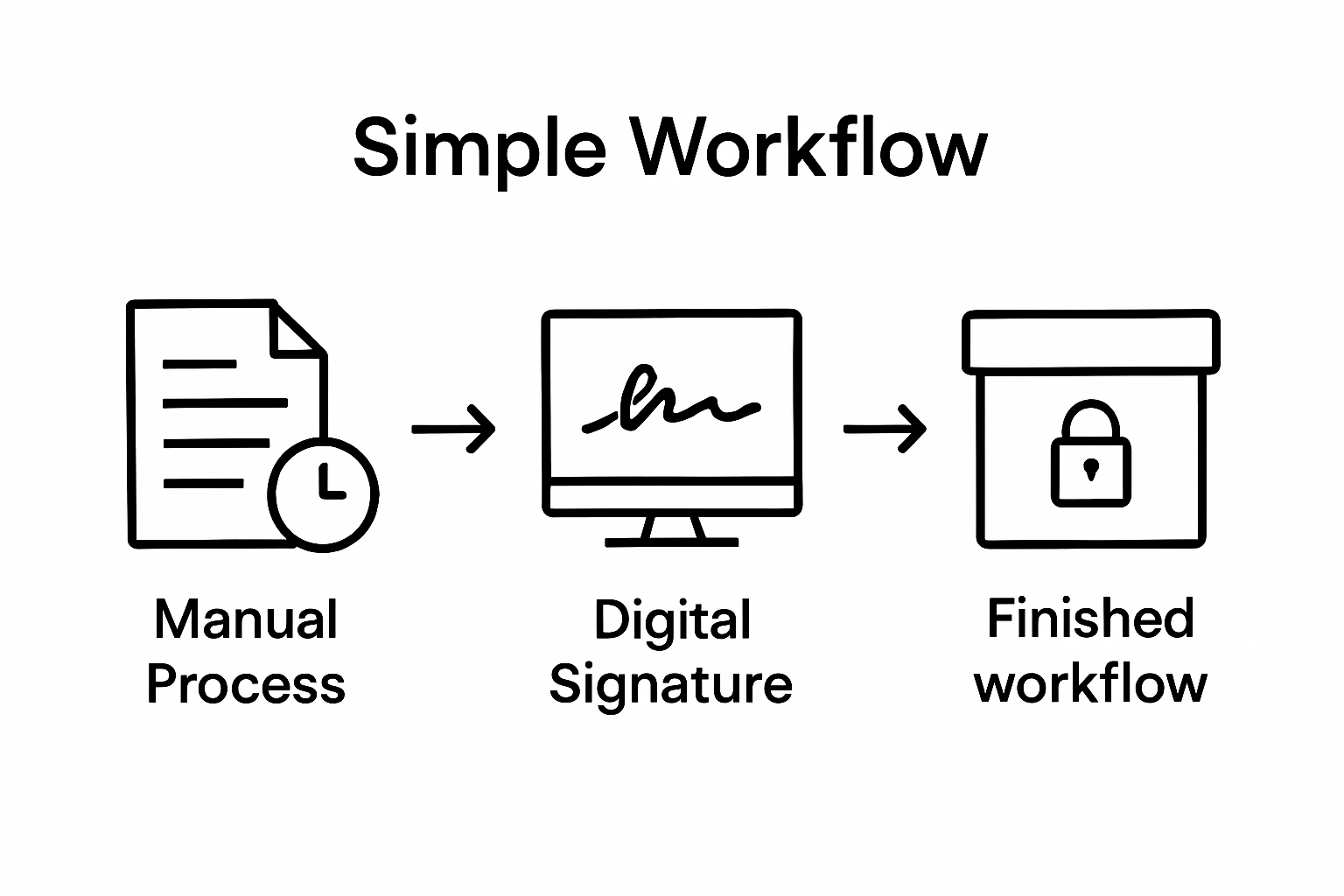Every business handles documents. Yet manual signature collection can drain hours from teams each week and often leads to hidden workflow delays. Most organizations believe their processes are as efficient as possible with the systems they already have. The real surprise is that electronic signatures do not just speed things up—they reveal unseen inefficiencies you never knew existed.

Table of Contents
- Step 1: Assess Your Current Document Workflow Processes
- Step 2: Choose Appropriate Adobe Electronic Signature Solutions
- Step 3: Configure Electronic Signature Settings In Adobe
- Step 4: Integrate Electronic Signatures Into Your Existing Workflows
- Step 5: Test And Verify The Electronic Signature Process
- Step 6: Monitor And Optimize Signature Processes For Efficiency
Quick Summary
| Key Point | Explanation |
|---|---|
| 1. Assess current document workflows | Audit existing document processes to identify inefficiencies and areas for improvement in your organization. |
| 2. Select appropriate Adobe solutions | Choose Adobe electronic signature tools that align with your specific operational needs and technology infrastructure. |
| 3. Configure signature settings carefully | Set up standardized templates and user permissions in Adobe to ensure security and efficiency in document signing. |
| 4. Integrate signatures into workflows | Strategically incorporate electronic signatures into existing processes, starting with high-volume departments for optimal impact. |
| 5. Monitor and optimize continuously | Use analytics to track performance and improve electronic signature processes regularly based on user feedback and efficiency metrics. |
Step 1: Assess Your Current Document Workflow Processes
Implementing electronic signatures begins with a critical foundational step: thoroughly understanding your organization’s existing document workflow processes. This comprehensive assessment will reveal inefficiencies, bottlenecks, and opportunities for digital transformation. By mapping out how documents currently move through your organization, you establish a clear baseline for implementing electronic signatures effectively.
Start by conducting a detailed audit of your document management practices. Walk through each department and document type systematically. Identify who creates documents, who requires approvals, where signatures are currently collected, and how long each process typically takes. Pay special attention to repetitive manual processes that consume significant administrative time. Look for scenarios where physical paperwork creates delays or introduces potential errors.
Document your current workflow by creating a visual representation. Sketch out or use workflow mapping software to track each document’s journey from creation to final archival. Highlight critical interaction points where signatures are required. This visual mapping helps reveal hidden inefficiencies that might not be immediately apparent through verbal discussions. During this process, interview key stakeholders from different departments to understand their specific document handling challenges.
Our comprehensive guide on document approval workflows provides additional insights into mapping organizational document processes. Pay particular attention to the following verification criteria during your assessment:
- Total number of documents processed monthly
- Average time spent on manual signature collection
- Number of departments involved in document approvals
- Current storage and archival methods
- Frequency of document routing errors
Successful completion of this assessment means you have a clear, documented understanding of your current document workflow. You will have identified specific pain points where electronic signatures can dramatically improve efficiency, reduce processing time, and minimize administrative overhead. By establishing this baseline, you create a strategic roadmap for implementing electronic signatures tailored precisely to your organization’s unique needs.
Below is a checklist table summarizing the key verification criteria you should document when assessing your current document workflow processes.
| Criteria | What to Verify |
|---|---|
| Total monthly documents processed | Volume of paperwork moving through your organization |
| Average manual signature collection time | Time teams spend securing handwritten approvals |
| Departments involved in approvals | Number of groups/personnel needed for sign-off |
| Storage and archival methods | Current processes for document retention and retrieval |
| Frequency of routing errors | How often documents are misrouted or mishandled |

Step 2: Choose Appropriate Adobe Electronic Signature Solutions
Selecting the right electronic signature solution requires careful evaluation of your organization’s unique requirements and technological infrastructure. Adobe offers robust tools that can transform how your business handles document authentication and workflow management. Your goal in this step is to match the most suitable Adobe electronic signature technology with your specific operational needs.
Begin by thoroughly assessing your current technological ecosystem. Understand the compatibility requirements across different departments and existing software platforms. Adobe Acrobat Sign provides versatile solutions that integrate seamlessly with most enterprise environments. Consider factors like user volume, document complexity, security requirements, and regulatory compliance standards specific to your industry. Some organizations might need advanced features like multi party signing, while others require basic signature capabilities.
Explore our comprehensive analysis of Adobe Acrobat Document Cloud solutions to understand the nuanced differences between various electronic signature platforms. When evaluating solutions, pay attention to critical selection criteria:
- Scalability of the signature solution
- Integration capabilities with existing systems
- Compliance with industry security standards
- Cost effectiveness across user tiers
- Mobile and cross platform accessibility
Carefully review licensing models and potential implementation costs. Some Adobe electronic signature solutions offer tiered pricing structures that can accommodate businesses of different sizes. Verify that the chosen solution provides comprehensive audit trails, encryption protocols, and legal validation mechanisms. The right electronic signature tool should not only streamline your document workflows but also provide robust security and compliance features that protect your organization’s digital transactions.
The following table compares critical factors to consider when choosing between different Adobe electronic signature solutions mentioned in the guide.
| Selection Factor | Description | Impact on Choice |
|---|---|---|
| Scalability | Ability to support varying user/document loads | Essential for growing organizations |
| Integration Capabilities | Works with existing systems and platforms | Ensures smooth workflow adoption |
| Security & Compliance | Meets industry standards & regulations | Critical for data protection |
| Cost Effectiveness | Pricing alignment with company size/needs | Affects long-term sustainability |
| Mobile Accessibility | Compatibility with phones/tablets | Enables on-the-go signing |
Step 3: Configure Electronic Signature Settings in Adobe
Configuring electronic signature settings represents a pivotal moment in implementing your digital document workflow. This step transforms theoretical planning into practical implementation by establishing the technical infrastructure that will support seamless, secure digital signatures across your organization. Precision during this configuration ensures smooth authentication processes and maintains rigorous security standards.
Begin by accessing your Adobe Acrobat Sign administrative console and systematically reviewing global settings. Create standardized signature templates that reflect your organization’s specific requirements. These templates should include consistent branding elements, signature placement guidelines, and authentication protocols. Pay close attention to user permission levels, ensuring that only authorized personnel can initiate or approve document signatures. Carefully map out different user roles such as administrators, signers, and approvers to maintain a clear hierarchy of document management responsibilities.
Explore our comprehensive guide on digital signature validation to understand advanced configuration nuances. When setting up your electronic signature environment, focus on these critical configuration parameters:
- Multi factor authentication requirements
- Signature validation protocols
- Document retention and archival policies
- Audit trail tracking mechanisms
- User access control settings
Successful configuration means establishing a robust electronic signature framework that balances operational efficiency with stringent security measures. Test your settings thoroughly by creating sample documents and running signature workflows with different user roles. Verify that signature placement, authentication steps, and document routing perform exactly as intended. This meticulous approach ensures your Adobe electronic signature solution will function seamlessly across various departmental contexts, providing a reliable digital transformation of your document management processes.
Refer to this table for a concise overview of critical Adobe configuration settings to review and set up during your electronic signature implementation.
| Setting | Purpose | Key Consideration |
|---|---|---|
| Signature Templates | Standardize layout/fields/branding | Align branding, ensure clarity |
| User Permissions | Control access and signature authority | Assign rights by department |
| Multi-Factor Authentication | Enhance security for signatories | Prevent unauthorized signing |
| Audit Trails | Record activity on each document | Enable compliance reporting |
| Document Retention Policies | Manage archival and retention lifespan | Meet legal & business needs |

Step 4: Integrate Electronic Signatures into Your Existing Workflows
Integrating electronic signatures into your existing workflows requires a strategic and methodical approach that minimizes disruption while maximizing operational efficiency. This step transforms your digital signature implementation from a standalone tool into a seamless component of your organization’s document management ecosystem. The goal is to create a fluid transition that enhances rather than complicates your current processes.
Begin by identifying specific document workflows where electronic signatures will provide the most immediate impact. Prioritize departments with high document volume and complex approval processes, such as human resources, finance, or legal departments. Develop a phased implementation strategy that allows for gradual adoption and real time learning. Start with a pilot program in one department, carefully documenting each step of the integration process. This approach enables you to identify potential challenges and refine your approach before full scale deployment.
Explore our detailed guide on PDF form management to understand advanced document workflow techniques. When integrating electronic signatures, focus on creating standardized templates and workflows that align with your organization’s specific requirements. Consider the following critical integration parameters:
- Mapping existing paper based approval routes
- Establishing digital signature validation protocols
- Creating automated routing and notification systems
- Ensuring compliance with industry specific regulations
- Developing comprehensive user training materials
Successful integration means creating a cohesive system where electronic signatures feel like a natural extension of your existing document management processes. Conduct thorough testing across different document types and approval scenarios. Verify that signature workflows function smoothly, maintaining the same level of security and accountability as traditional manual processes. Gather feedback from users during the initial implementation phase, and be prepared to make iterative improvements to optimize the electronic signature workflow.
Step 5: Test and Verify the Electronic Signature Process
Testing and verifying your electronic signature process represents the critical validation phase that ensures your digital transformation meets stringent operational and legal requirements. This step transforms theoretical configurations into a robust, reliable system that can withstand real world document authentication challenges. Comprehensive testing protects your organization from potential workflow disruptions and security vulnerabilities.
Design a multilayered testing strategy that simulates diverse document scenarios across different departments. Create test documents representing various complexity levels. Include standard forms, contracts, approval workflows, and sensitive documents that require multiple signatories. Execute signature processes with test user accounts representing different organizational roles and permission levels. Pay special attention to authentication mechanisms, signature placement accuracy, and document routing protocols. Verify that audit trails capture every interaction precisely, providing a comprehensive record of each digital transaction.
Research on electronic signature implementation highlights the importance of rigorous validation processes. When conducting your verification, focus on these critical testing parameters:
- Complete end to end signature workflows
- Cross platform and device compatibility
- Security encryption validation
- Compliance with industry specific regulations
- Performance under high document volume scenarios
Successful testing means establishing absolute confidence in your electronic signature system. Document every test scenario, recording specific outcomes, potential issues, and resolution strategies. Create a comprehensive test log that demonstrates the system’s reliability, security, and efficiency. This meticulous approach ensures your electronic signature implementation delivers seamless, trustworthy document management capabilities that enhance organizational productivity while maintaining the highest standards of digital authentication.
Step 6: Monitor and Optimize Signature Processes for Efficiency
Monitoring and optimizing electronic signature processes represents the continuous improvement phase of your digital transformation journey. Establishing a proactive performance management strategy ensures your electronic signature workflow remains dynamic, responsive, and aligned with evolving organizational needs. This step transforms your initial implementation into a sophisticated, data driven document management system.
Begin by implementing comprehensive analytics tracking within your Adobe electronic signature platform. Develop a dashboard that captures critical performance metrics such as average signature turnaround times, document routing efficiency, and user engagement levels. Regularly review these metrics to identify potential bottlenecks or areas requiring process refinement. Pay close attention to variations across different departments, as each may have unique workflow characteristics that demand tailored optimization strategies. Conduct periodic user feedback sessions to understand practical challenges and gather insights directly from team members who interact with the electronic signature system daily.
Learn more about efficient batch processing techniques to enhance your document workflow optimization. When monitoring your electronic signature processes, focus on these critical performance parameters:
- Document processing speed and turnaround times
- User authentication success rates
- Compliance and security validation metrics
- System resource utilization
- User adoption and satisfaction levels
Successful optimization means creating a continuously evolving electronic signature ecosystem that adapts to changing business requirements. Implement a quarterly review process where you analyze performance data, gather stakeholder feedback, and make incremental improvements. Be prepared to adjust signature workflows, refine authentication protocols, and introduce new features that enhance overall system efficiency. This iterative approach ensures your electronic signature solution remains a strategic asset that drives organizational productivity and digital transformation.
Here is a summary table of critical performance metrics you should monitor after implementing electronic signatures to ensure continued optimization and efficiency.
| Performance Metric | What It Measures | Importance for Optimization |
|---|---|---|
| Document Processing Speed | Average time to complete signatures | Reveals process bottlenecks |
| Authentication Success Rate | Percentage of completed authentications | Highlights user or system issues |
| Compliance Validation | Frequency of meeting regulations | Essential for legal adherence |
| System Resource Utilization | Platform/server workload levels | Guides scaling and troubleshooting |
| User Adoption & Satisfaction | Feedback and usage rates | Indicates need for training/support |
Take the Next Step Toward Effortless Digital Workflows
Is your organization struggling with manual document signing, slow approval chains, or the risk of errors in your existing PDF workflows? After reading about mapping internal processes, choosing the right signature tools, and integrating secure approval systems, you know how essential streamlined PDF handling is for business efficiency and compliance. Every hour lost to paper-based signatures adds up, creating real stress and missed opportunities.

Let
Mapsoft.com
help you put these best practices to work today. Explore how our advanced Adobe-centric solutions, plug-ins, and the web-based
Mapsoft PDF Hub
tackle batch processing, automated workflow integration, and robust e-signature support. When you need custom development or tools that boost productivity for complex documents, Mapsoft delivers expertise that turns your electronic signature plans into reality. Connect now to see how your document automation journey can start strong and stay simple.
Frequently Asked Questions
How do I start implementing electronic signatures in my organization?
Begin by assessing your current document workflow processes. Conduct a thorough audit of how documents move through your organization to identify inefficiencies and opportunities for digital transformation before implementing electronic signatures.
What factors should I consider when choosing an electronic signature solution?
When selecting an electronic signature solution, consider compatibility with existing software, scalability, security compliance, cost-effectiveness, and specific features needed for your organization, such as multi-party signing or mobile accessibility.
How can I ensure that my electronic signature processes are secure?
To ensure security, configure multi-factor authentication, establish clear user permission levels, and implement encryption protocols. Additionally, choose a solution that provides comprehensive audit trails and compliance with industry standards.
What steps should I take to optimize electronic signature processes after implementation?
Monitor key performance metrics such as signature turnaround times and user engagement levels. Regularly gather user feedback and conduct quarterly reviews to identify bottlenecks and make incremental improvements to enhance efficiency.
Recommended
- Digital Signature Validation for Enhanced Efficiency
- Understanding the Importance of Document Security –
- Why Custom Software Solutions Are Key to Business Efficiency
Conclusion
- In summary, implementing electronic signatures can transform document management.
- Implementing electronic signatures helps in expediting customer approvals and sign-offs.
- Many businesses are finding success by implementing electronic signatures in their workflows.
- Implementing electronic signatures can also support remote work policies.
- Firms that are implementing electronic signatures often report increased employee satisfaction.
- Implementing electronic signatures also enhances compliance with legal regulations.
- Another benefit of implementing electronic signatures is improved document security.
- Organizations often find that implementing electronic signatures can lead to significant cost savings.
- Implementing electronic signatures helps in reducing the overall processing time for document approvals.
- By effectively implementing electronic signatures, organizations can streamline their processes.



